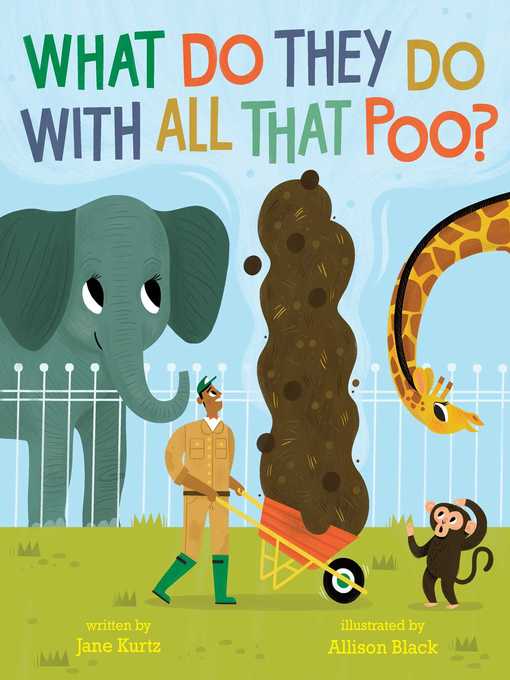
What Do They Do with All That Poo?
فرمت کتاب
ebook
تاریخ انتشار
2018
Lexile Score
910
Reading Level
3-5
ATOS
4.5
Interest Level
K-3(LG)
نویسنده
Allison Blackناشر
Beach Lane Booksشابک
9781481479875
کتاب های مرتبط
- اطلاعات
- نقد و بررسی
- دیدگاه کاربران
نقد و بررسی

April 15, 2018
Countless zoo books line the shelves, but how often does one discuss animal manure--and how a zoo discards it?Employing the page turn to great effect from the very start, Kurtz is bound to get youngsters' attention: "At zoo after zoo / the animals chew. / And then ... // they poo!" Quick rhymes in boldface type across the top make simple statements about each animal's toilet habits. "Sloths creep down from trees to poop, / but only once a week. / A penguin shoots its poo out / in a fishy-smelling streak." Smaller text below offers more in-depth facts: "Why do sloths spend so much energy leaving the protection of trees to poop on the ground? It's a mystery scientists are trying to solve." Black's wide-eyed, expressive animals have personality, but they never cross over to cartoony garishness. After exploring 12 different zoo dwellers, Kurtz then turns her focus to the large amount of poo that accumulates at a zoo every day. What do they do with it? Much is trucked to landfills, but zoos also study it in labs to help understand their animals better. Plus, there are compost options and even elephant-poo paper! A slapdash ending is the only misstep, but the atypical subject matter will surely shine.A scatological success. (Informational picture book. 3-8)
COPYRIGHT(2018) Kirkus Reviews, ALL RIGHTS RESERVED.

April 23, 2018
Kurtz (Planet Jupiter) playfully delves into the diversity of dung found at the zoo in her latest picture book. “A wombat’s poo is cube-shaped, so it isn’t very roly. / Some snakes poop only once a year. They digest their food sloooow-ly.” Simple rhyming couplets deliver the facts, with accompanying sentences providing additional detail (e.g., “Wombats are highly territorial. They each deposit 80–100 droppings every evening as a signpost to say ‘I’m here.’ ”). The first half of the book discusses how various creatures take care of back-end business, while the second describes how zoos manage all that manure (much of it is trucked to landfills, while some is composted into “Zoo Doo,” among other things). The brightly colored, cartoon-style illustrations by Black (Barnyard Boogie!) add levity, as hippos grin, sloths smile, and bats beam. Poop of various sizes is buried, sniffed, squirted, weighed, and even thrown. Young readers going through a bathroom-humor stage should enjoy the topic and the book’s light tone but, whether appreciative, awed, or grossed out, all will come away informed. Ages 3–8.

May 1, 2018
K-Gr 2-This nonfiction read-aloud for the younger set will have kids in giggles. Each page features rhyming text that describes a different animal's waste product, with more information at the bottom of the page. Kurtz also details exactly what zoos do with all that waste: take it to the dump, use it for research, or sell it as compost. The rhyming aspect makes this an excellent choice for preschool students. Insightful details about animal poop strike a smart balance between amusement and fact-based trivia (e.g., wombat poop is cube-shaped). Black's high-contrast, bouncy artwork accurately depicts the narrative and will enhance readers' understanding. The playful geometric digital illustrations pop with color and have a lot of kid appeal. Human characters appear only briefly. While not an in-depth study, kids will be having so much fun they won't notice they're learning. VERDICT A humorous addition to most nonfiction collections.-Richelle Rose, Kenton County Public Library, KY
Copyright 2018 School Library Journal, LLC Used with permission.

April 15, 2018
Grades K-2 There's quite a lot here to digest. In a mix of rhymed general statements and, in smaller type, pithy prose explanations, Kurtz drops nuggets of information about what poop is, how the excrement of a dozen types of zoo animals differs in shape and composition, what said animals do with their poop in nature, and the many ways zoos (and gardeners) study and recycle all those tons of zoo-doo. She closes with the provocative observation that more intelligent and socialized primates tend to fling their poop with more accuracy than their duller cohorts?as, perhaps, a form of communication and self-expression. Reflecting what young readers will be doing by this point, Black illustrates the author's final sally with a troop of heartily laughing monkeys. In fact, all the creatures in these brightly colored cartoon illustrations, even the earthworms, are smiling. So are most of the notably diverse cast of human workers (a few pooper-scoopers look understandably beleaguered), as befits both the topic and the tone of this fresh scoop on poop.(Reprinted with permission of Booklist, copyright 2018, American Library Association.)

























دیدگاه کاربران